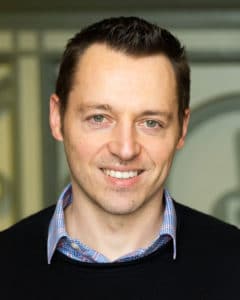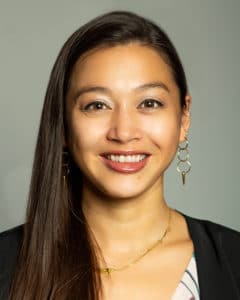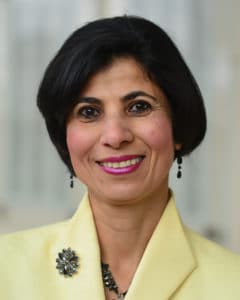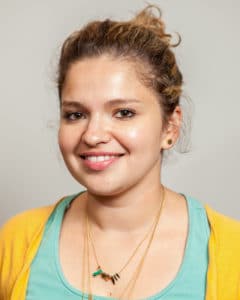Posted on December 4, 2019 in ASRC News, Featured News
Eight science faculty members from across CUNY have been selected to receive ASRC Seed Grants for their early-stage research projects. Now in its fifth year, the grant program will provide each recipient $15,000 to support research conducted between November 1, 2019 and July 31, 2020. The grant will cover the cost of key research staff and use of the ASRC’s state-of-the-art core research facilities.
In keeping with the Seed Grant Program’s goal of fostering interdisciplinary research, each recipient will also partner with research faculty in one of the ASRC’s five initiatives (Nanoscience, Photonics, Structural Biology, Neuroscience and Environmental Sciences) to incorporate principles and approaches from other disciplines that can help advance the research project’s goals.
This year’s winners are investigating a wide range of projects, including the development of novel clean energy-harvesting methods, creating noninvasive deep brain stimulation techniques for treating neurological and psychiatric disorders, and controlling the speed of light to facilitate development of quantum computers. Here’s a look at this year’s winners.
 |
Professor Ana Carnaval, The City College of New York, Biology DepartmentASRC Partner: Professor Andrew Reinmann, Environmental Sciences Initiative Project Name: Harnessing Ecophysiology and Evolutionary Theory to Improve Models of Biodiversity and Ecosystem Function Goal: The team aims to develop a more accurate model for predicting distribution patterns of plant species under future climate conditions in order to mitigate the effects of environmental change on plant biodiversity ecosystem function. |
 |
Professor Jacek Dmochowski, The City College of New York, Biomedical Engineering DepartmentASRC Partners: Professor A. Duke Shereen, Neuroscience Initiative, and Research Associate Dmitriy Korobkin, Photonics Initiative Project Name: Deep Brain Light Stimulation Goal: The team is working to develop and validate a new, noninvasive technique to stimulate deep brain regions using near-infrared light as a therapy for neurological and psychiatric disorders. |
 |
Professor M. Lane Gilchrist, The City College of New York, Chemical Engineering DepartmentASRC Partner: Professor Xi Chen, Nanoscience Initiative Project Name: Isolation of Peptifoglycan from Hyperthemophillic Microorganisms for New Bioinspired Water Responsive Materials Goal: The research team aims to develop a scalable method of creating water-responsive nanomaterials that can enable a new method of clean energy harvesting. |
 |
Professor Igor Kuskovsky, Queens College, Physics Department(w/ co-PI Professor Maria Tamargo, The City College of New York, Chemistry Department)ASRC Partner: Professor Milan Bergliarbekov, Nanoscience Initiative Project Name: Development of High Efficiency Intermediate Band Photovoltaic Devices Goal: Kuskovsky’s team is endeavoring to use a novel material system developed by City College researchers to create solar cells that are significantly more efficient. |
 |
Professor Mohammad-Ali Miri, Queens College, Physics DepartmentASRC Partner: Professor Gabriele Grasso, Photonics Initiative Project Name: Slow Light Based on Transition Metal Dichalcogenide Monolayers Goal: The team aims to create nanofabricated structures capable of slowing the movement of light in order to better facilitate light-matter interactions with 2D materials and ultimately advance development of quantum computers. |
 |
Professor Erika Niwa, Brooklyn College, Psychology Department(w/ co-PI Professor Monica Trujillo, Queensborough Community College, Biology Department)ASRC Partner: Professor Peter Groffman, Environmental Sciences Initiative Project Name: Seeking Ground: An Interdisciplinary Study of the Restoration of Newtown Creek Goal: This team aims to develop an emerging multidisciplinary collaboration between a microbiologist, a psychologist, and a biogeochemist to research links between ecological and community health. |
 |
Professor Ghada Soliman, CUNY Graduate School of Public Health & Health Policy, Environmental Health DepartmentASRC Partners: Professor Rinat Abzalimov, Structural Biology Initiative, and Professor Ye He, Neuroscience Initiative Project Name: mTORC1/mTORC2 Impact on the Untargeted Metabolomics and Mitochondrial Functions in Pancreatic Islet β Cell Lines. Goal: Soliman’s team is endeavoring to elucidate the role of two protein complexes (mTORC1 and mTORC2) in the development of type 2 diabetes. |
 |
Professor Mariana Torrente, Brooklyn College, Chemistry DepartmentASRC Partner: Professor Shana Elbaum-Garfinkle, Structural Biology Initiative Project Name: Prions Meet Phase Separation: Rnq1/[PIN+] Goal: The research team aims to determine whether the yeast prion protein Rnq1 undergoes a process called phase separation; the sequence determinants for this process; and how it might have a role in normal and aberrant cell biology. |
